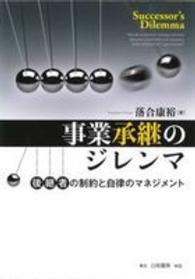- ホーム
- > 洋書
- > 英文書
- > History / World
Full Description
In 1922-23, Chinese students in Victoria, British Columbia, went on strike to protest a school board's attempt to impose segregation. Their resistance was unexpected at the time and runs against the grain of mainstream accounts of Asian exclusion, which tend to ignore the agency of the excluded.
Contesting White Supremacy offers an alternative reading of racism in British Columbia. Drawing on Chinese sources and perspectives and an innovative theory of racism and anti-racism to explain the strike, Timothy Stanley demonstrates that by the 1920s migrants from China and their BC-born children actively resisted policy makers' efforts to organize white supremacy into the very texture of life. The education system served as an arena where white supremacy confronted Chinese nationalist schooling and where parents and students rejected the idea of being either Chinese or Canadian and instead invented a new category - Chinese Canadian - to define their identity.
Contents
Introduction: Questioning the Existence of the World
1 The 1922-23 Students' Strike
Part 1: Racism
2 Anti-Chinese Racism and the Colonial Project of British Columbia
3 Racializing 'the Chinese,' Racializing 'the Canadian'
4 Schooling and the Organization of Racist State Formation
5 The Chinese Archipelago in Canada and the Consequences of Racialized Exclusion
Part 2: Anti-Racism
6 Resisting Racialization and the Invention of Chinese Canadians
7 Making Inclusions and Chinese Nationalist State Formation in Canada
8 Mitigating Racism through Chinese Nationalist Schooling
9 Anti-Essentialist Anti-Racisms and the Resistances of Odd Places
Conclusion: Anti-Racism, History, and the Significance of Chinese Canadians
Appendix
Notes
Select Bibliography
Index







